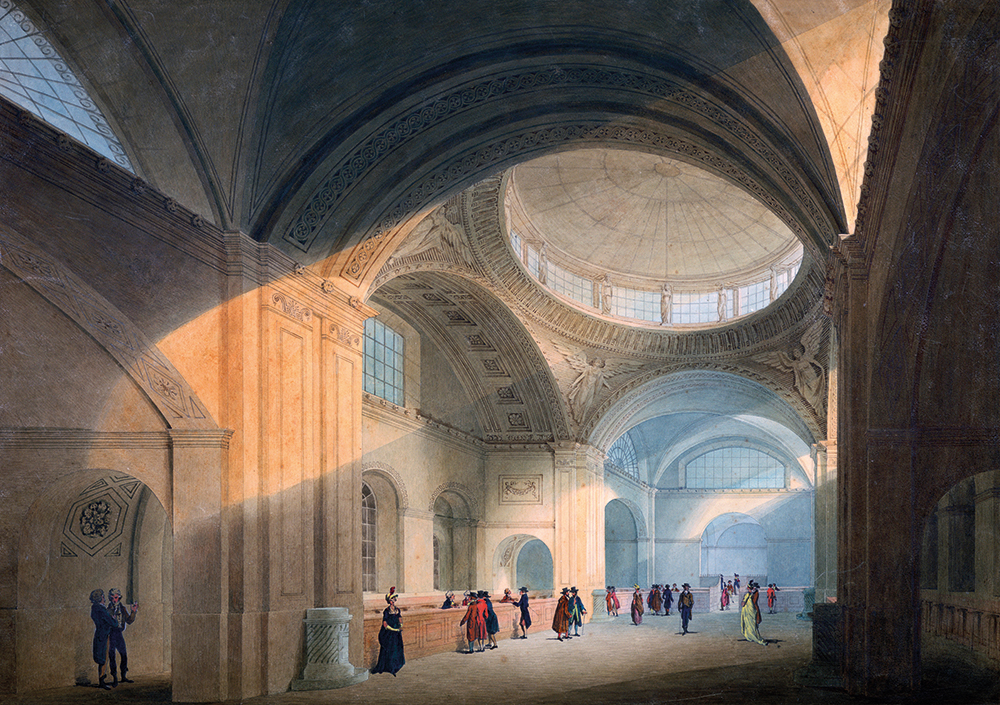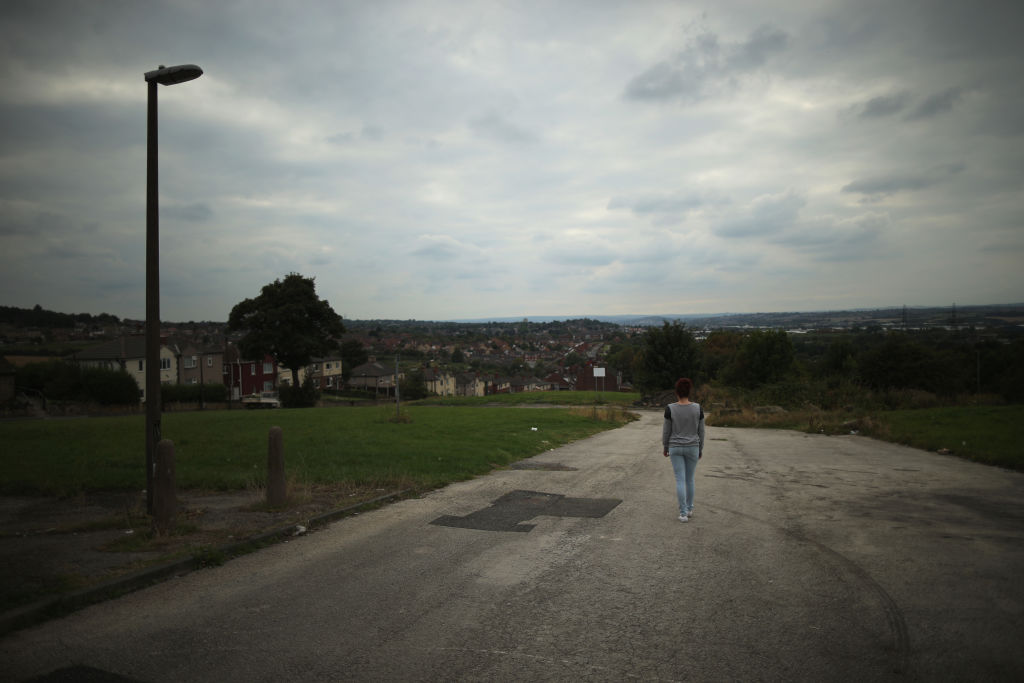In 1916 the Bank of England committed what Nikolaus Pevsner was to call the greatest architectural crime to befall London in the 20th century. It decided to demolish much of its own building, designed by the great Georgian neoclassical architect John Soane.
Soane’s lost masterpiece is the subject of the latest series from the essential architecture podcast About Buildings and Cities. The podcast, started in 2016 by presenters Luke Jones and George Gingell as a hobby, has slowly become a fan-funded staple for architects, offering a re-evaluation of the received wisdoms about the canon and some affable banter along the way.
He built a rich ‘internal world’, lit by roof lanterns that crown dramatic vaulted spaces
Soane worked on the Bank of England for almost 50 years. And the job provides the keystone to a sweeping look at the arc of his career. Even while still in training Soane had a thirst to prove himself with ‘banger megalomaniac student projects’, namely his over-elaborate ‘Triumphal Bridge’, which showed off his mastery of the classical idiom. Then there’s the familiar hustling: as a bricklayer’s son he juggled scholarships, jobs and opportunistic freelance commissions to fund his education and Grand Tour.
As practitioners rather than historians, both Jones and Gingell are attuned to the mundanities of architectural practice that are vital to make sense of Soane’s career. Too often these are glossed over by academia, or by an architect’s own heroic narratives (Soane, like all great architects, was a studious self-promoter). They reveal how Soane honed his craft in even the ‘least interesting early career projects’ including his idiosyncratic but inventive reinterpretations of ancient Greek architecture. Google, for example, his dairy for Hamels Park which has a portico, albeit with a thatched roof and unhewn tree trunks in place of Doric columns (an architect’s inside joke about the supposed timber origins of the classical order).
He also developed his business savvy, reflecting the wider transition of architecture from a gentlemanly hobby to an institutionalised profession. Most telling was his relationship with Frederick Hervey, Bishop of Derry and later Earl of Bristol (the ‘Bishop-Earl’), his friend, patron, then nightmare client, simultaneously ‘opinionated’ yet ‘vacillating’. Soane developed a prolific tendency to churn out design options, not only proving his exhaustive imagination, but also what Gingell calls ‘toddler-management skills’, distracting clients with the illusion of choice while getting on with the important design decisions. These skills would become essential as he started competing for larger commissions, such as (unsuccessfully) Greenwich Hospital.
The Bank of England job was his big break. With its own episode that lasts as long as a feature-length film (and that’s just the highlights), Soane’s immensely complex design for the Bank perhaps stretches past the limits of the spoken word as a medium for discussing architecture. Here, YouTube versions of the podcast, with photographs and drawings, become essential.
This complexity is warranted: the Bank, when it first moved to Threadneedle Street in 1734, only had a constrained plot in the dense, medieval City. As the role of the Bank evolved, it also incrementally doubled in area to its full 3.5-acre site today. Soane inherited the work of his predecessors, George Sampson and Robert Taylor, which he retained in part. (One of the oldest banking halls by Sampson also survived until the 1920s.) Soane’s Bank is evidently not designed freely from tabula rasa. Instead, Soane coaxed out eventual coherence, piecemeal, over decades.

While Jones and Gingell admit the difficulty in making sense of an ‘organic’ building with ‘no central organisation’, they suggest the key to understanding it: security. Scarred by the 1780 Gordon Riots when the Bank was mobbed, the authorities decided that making the building impregnable was critical. Soane’s solution was to enclose the entire site with a solid screen-wall, and build a rich ‘internal world’, lit by roof lanterns that crown dramatic vaulted spaces and courtyards instead of street-facing windows. Jones exposes one of the tricks of the architectural trade: under the pragmatic guise of security and critical repairs, Soane justified to the governors increasingly elaborate and fanciful schemes for achieving this – and then some.
Unlike its remoteness today, the Bank of Soane’s day was largely made up of public-facing spaces, where everything from trading securities to collecting bond-coupon payments would happen in person. In contrast to the ‘fine and frilly’ banking halls left by previous architects, Soane’s had ‘big, strong, primal intersecting shapes’, where ornamentation was pared back to highlight complex compositions of vaults, domes and pendentives. It’s an elemental classicism that harks back to the Roman Baths of Diocletian or the Byzantine Hagia Sophia, a geometric sanctification of high finance.
Doubtless, Soane was proud of his tectonic talents: Jones and Gingell have found beautiful mid-construction watercolours that document how these vaulted spaces were carefully put together with stone and hollow terracotta tubes, prior to it all being hidden with plaster. (Today’s architects would have happily left this exposed.)
Even back of house gets the Soane treatment. He designed a ‘ceremonial route’ for the gold bullion, which could now process from its own entrance at Lothbury into the inner sanctum of the Bank, the Bullion Office. His Lothbury Court heralded the gold’s arrival, where it was flanked by a guard of honour of Corinthian columns and urns, with designs of the gateway (somewhat heavy-handedly) based on the triumphal Arch of Constantine.
Behind the scenes, Jones and Gingell reveal the design headaches Soane resolved effortlessly, from level changes to awkward clashing angles, through cleverly positioned semi-circular rooms. Within a decade of all this being demolished, Britain would leave the gold standard, severing the currency’s link with the value of gold. Without giving the architects too much credit, it might be a case of function following form.
Tragically, by the 1920s, the Bank’s expanded ranks outgrew Soane’s single-storey building. Even prior to nationalisation in 1946, the Bank was already a de facto central bank focusing on public responsibilities, despite being a private institution. Soane’s voluminous halls, no longer public-facing, were instead full of desks. To avoid having multiple headquarters, architect Herbert Baker was appointed to replace Soane’s Bank with an introspective citadel of cubicles. Only parts of Soane’s screen-wall were retained. As Jones remarked, looking at 1920s photos documenting Soane’s Bank prior to and during demolition, ‘they must’ve known what they were doing was wrong’.
Soane’s BoE was undoubtedly one of British architectural history’s greatest losses
Jones and Gingell’s thorough look at Soane’s Bank moved me to inspect the damage in person. Armed with some old paper banknotes with their age-old promise to pay the bearer, I went to the Bank to experience the few public-facing spaces left. Looking from the Royal Exchange, Pevsner wasn’t exaggerating when he accused Baker of using Soane’s screen-wall as ‘a footstool’ for his own looming edifice and not allowing it to become the romantic ruin Soane once envisioned for his building’s future. After a security check, we were ushered to queue in a banking hall that bore a striking resemblance to Soane’s style, with its alternating vaulted and domed spaces. Despite Baker’s seven-storey offices overshadowing them, the roof lanterns, adorned by caryatids and Ionic columns, created a light and airy space with uncompromising geometry.
But make no mistake, these are Baker’s mere paraphrased recreations of Soane’s last two banking halls: the lanterns were less elaborate with a single-tiered design and solid roofs instead of glass, and the sequence of vaulted and domed spaces was changed. Only in the Stock Office, which was recreated faithfully in the 1980s and now houses the Bank’s museum, can you still see the unadulterated genius of Soane. Here, I felt I’d stepped into the atmospheric renderings of Joseph Gandy (Soane’s preferred watercolourist) and felt a pang of grief over everything that was destroyed.
Soane’s Bank of England was undoubtedly one of British architectural history’s greatest losses. But this would be just one of Soane’s career-long preoccupations: the podcast’s next episode explores his work on the Palace of Westminster, where even less survives, thanks to the 1834 fire and Soane losing a far older culture war (whether parliament should be classical or gothic).
In both sprawling complexes, Soane demonstrated his talent in ‘the art of fudging things together’ that place him above the classicism-by-numbers of his peers. His ability to retain, adapt and reinvent helped create buildings for the modernising British state with a sense of coherent continuity woven into the architectural fabric. As for whether the Bank of England, had it kept Soane’s originals instead of replicas, would have been inspired by this authentic continuity to steward our economy differently, one can only speculate.
About Buildings and Cities is available on Apple, Spotify, YouTube and other platforms.







Comments